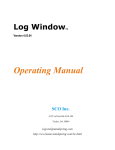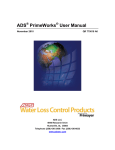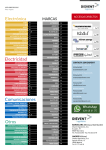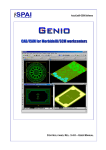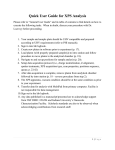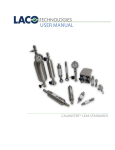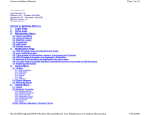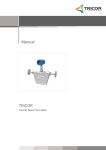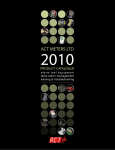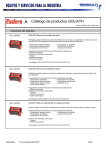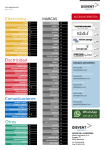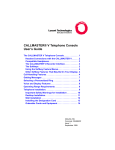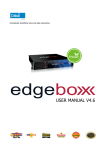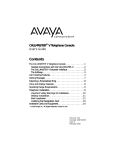Download Aquamaster User Manual
Transcript
User Guide OI/FET2XX–EN Rev. B AquaMaster 3 Electromagnetic flowmeter The smart solution for remote applications Introduction AquaMaster 3TM is a range of high performance electromagnetic flowmeters for the measurement of electrically-conductive fluids and is normally supplied as factory-configured, calibrated systems. This User Guide provides end-user details for AquaMaster 3 close-coupled and remote transmitters. When the meter is taken out of storage and installed for first use, remove the protective label (if fitted) from the front to enable light to activate the unit. If the meter is not powered, connect any batteries or external supply as detailed in this manual. This User Guide should be used in conjunction with the following publications: – Programming Guide (COI/FET2XX–EN) – MODBUS Tables Supplement (COI/FET2XX/MOD/TBL–EN) AquaMaster 3 Electromagnetic flowmeter 1 Safety ............................................................................................................................................... 3 1.1 1.2 1.3 2 Mechanical Installation .................................................................................................................... 5 2.1 2.2 2.3 2.4 3 Electrical Safety ............................................................................................................................................. 3 Symbols ........................................................................................................................................................ 3 Health & Safety ............................................................................................................................................. 4 Unpacking .................................................................................................................................................... 5 Installation Conditions ................................................................................................................................... 5 Dimensions ................................................................................................................................................. 11 2.3.1 AquaMaster 3 ............................................................................................................................... 11 2.3.2 Terminal Box – Sensor-mounted .................................................................................................. 12 GSM-equipped Transmitters ....................................................................................................................... 13 2.4.1 GSM Antenna Installation ............................................................................................................. 13 2.4.2 Connecting a Remote Antenna ..................................................................................................... 14 2.4.3 Installing a SIM Card ..................................................................................................................... 15 Electrical Installation ..................................................................................................................... 16 3.1 3.2 3.3 3.4 3.5 Grounding ................................................................................................................................................... 16 Connections ................................................................................................................................................ 18 3.2.1 AquaMaster 3 Connections .......................................................................................................... 18 3.2.2 Use of Tamper-detection Seals .................................................................................................... 19 Input / Output Connections ......................................................................................................................... 20 3.3.1 Frequency Outputs ....................................................................................................................... 20 3.3.2 Alarm Interface ............................................................................................................................. 21 3.3.3 Input / Output Connections .......................................................................................................... 21 3.3.4 ScanReader Interface (Option) ...................................................................................................... 22 3.3.5 RS232 Local Computer Connection ............................................................................................. 22 3.3.6 Pressure Transducer (Optional) ..................................................................................................... 23 3.3.7 Anti-tamper Protection ................................................................................................................. 24 MODBUS Connection ................................................................................................................................. 25 3.4.1 2-wire Connection ....................................................................................................................... 26 3.4.2 Host Computer Interface .............................................................................................................. 26 3.4.3 Pull-up and Pull-down Resistors / Polarization .............................................................................. 26 3.4.4 Termination Resistor .................................................................................................................... 27 3.4.5 Cable Properties ........................................................................................................................... 27 Power Supply Connections ......................................................................................................................... 28 3.5.1 Mains Power Supply ..................................................................................................................... 28 3.5.2 Battery Power Supply ................................................................................................................... 29 3.5.3 Renewable Energy Supply ............................................................................................................ 30 User Guide OI/FET2XX–EN Rev. B 1 AquaMaster 3 Electromagnetic flowmeter 4 Start-Up and Operation ................................................................................................................. 31 4.1 4.2 4.3 4.4 4.5 5 Start-up ....................................................................................................................................................... 31 Display Activation ........................................................................................................................................ 32 Display Information ...................................................................................................................................... 32 Servicing Plugs and Sockets ....................................................................................................................... 33 4.4.1 Service Intervals ............................................................................................................................ 33 4.4.2 Equipment Required ..................................................................................................................... 34 4.4.3 Preparation ................................................................................................................................... 34 4.4.4 Disconnection ............................................................................................................................... 34 4.4.5 Order of Treatment ....................................................................................................................... 35 4.4.6 Stage 1 – Oxide Removal and Cleaning ........................................................................................ 35 4.4.7 Stage 2 – Oxide Prevention .......................................................................................................... 36 4.4.8 Completion Tasks ......................................................................................................................... 36 Accessories / Spares Kits ............................................................................................................................ 37 Specification ................................................................................................................................... 38 Appendix A Hazardous Area Protection ............................................................................................. 51 A.1 Notes 2 GSM-Equipped Units – Safety Precautions .................................................................................................. 51 .................................................................................................................................................. 52 User Guide OI/FET2XX–EN Rev. B AquaMaster 3 Electromagnetic flowmeter 1 Safety 1 Safety Information in this manual is intended only to assist our customers in the efficient operation of our equipment. Use of this manual for any other purpose is specifically prohibited and its contents are not to be reproduced in full or part without prior approval of the Technical Publications Department. 1.1 Electrical Safety This equipment complies with the requirements of CEI/IEC 61010-1:2010 'Safety Requirements for Electrical Equipment for Measurement, Control and Laboratory Use' and complies with US NEC 500 and Occupational Safety & Health Administration. If the equipment is used in a manner NOT specified by the Company, the protection provided by the equipment may be impaired. 1.2 Symbols One or more of the following symbols may appear on the equipment labelling: Warning – Refer to the manual for instructions Direct current supply only Caution – Risk of electric shock Alternating current supply only Protective earth (ground) terminal Both direct and alternating current supply Earth (ground) terminal The equipment is protected through double insulation User Guide OI/FET2XX–EN Rev. B 3 AquaMaster 3 Electromagnetic flowmeter 1 Safety 1.3 Health & Safety Health and Safety To ensure that our products are safe and without risk to health, the following points must be noted: The relevant sections of these instructions must be read carefully before proceeding. Warning labels on containers and packages must be observed. Installation, operation, maintenance and servicing must only be carried out by suitably trained personnel and in accordance with the information given. Normal safety precautions must be taken to avoid the possibility of an accident occurring when operating in conditions of high pressure and / or temperature. Chemicals must be stored away from heat, protected from temperature extremes and powders kept dry. Normal safe handling procedures must be used. When disposing of chemicals ensure that no two chemicals are mixed. Safety advice concerning the use of the equipment described in this manual or any relevant hazard data sheets (where applicable) may be obtained from the Company contact details on the back cover, together with servicing and spares information. Warning. 4 Installation and maintenance must be carried out only by suitably trained personnel. Read all relevant sections of this manual before selecting a location. The safety requirements of this equipment, any associated equipment and the local environment must be taken into consideration during installation. Install and use this equipment in accordance with relevant national and local standards. Specific safety precautions apply to the use of the GSM engine that forms part of the GSM-equipped version of this product. If the unit purchased has GSM-capability, read Appendix A on page 51 before selecting a location. User Guide OI/FET2XX–EN Rev. B AquaMaster 3 Electromagnetic flowmeter 2 Mechanical Installation 2 Mechanical Installation 2.1 Unpacking Fig. 2.1 Unpacking 2.2 Installation Conditions Caution. Do NOT exceed the maximum working pressure marked on the equipment. Fig. 2.2 Spillage User Guide OI/FET2XX–EN Rev. B 5 AquaMaster 3 Electromagnetic flowmeter 2 Mechanical Installation Fig. 2.3 Vibration Fig. 2.4 Localized Heat Close-coupled Version Allow room to read data plate Fig. 2.5 Siting 6 User Guide OI/FET2XX–EN Rev. B AquaMaster 3 Electromagnetic flowmeter 2 Mechanical Installation 70 °C (158 °F) Maximum 60 °C (140 °F) Maximum –10 °C (14 °F) Minimum –20 °C (–4 °F) Minimum Fig. 2.6 Within Temperature Limits Full Bore Sensor (MM/GF) Reduced Bore Sensor (MM/GA) 2 x Pipe Dia. 5 x Pipe Dia. 0 x Pipe Dia. 0 x Pipe Dia. Minimum Minimum Flow Direction Fig. 2.7 Straight Pipe Requirements Fig. 2.8 Fluid Level User Guide OI/FET2XX–EN Rev. B 7 AquaMaster 3 Electromagnetic flowmeter 2 Mechanical Installation Fig. 2.9 Shade <2 m 78 in.) IP68 (NEMA 6P) ENCLOSURE 6P Submerged – 9 Months Accrued Time Not applicable to GSM Integral Aerial Installations – see section 2.4.1, page 13 Fig. 2.10 Within Environmental Rating Supports Fig. 2.11 Above Ground Fig. 2.12 Temperature Difference 8 User Guide OI/FET2XX–EN Rev. B AquaMaster 3 Electromagnetic flowmeter 2 Mechanical Installation Adequate Protection Plate (Recommended) Backfill Fig. 2.13 Underground Note. For further details when burying flow sensors contact the ABB Service Organisation. Fig. 2.14 Cable Routing Fit Gaskets Gaskets same size as pipe Fig. 2.15 Gasket Fitting User Guide OI/FET2XX–EN Rev. B 9 AquaMaster 3 Electromagnetic flowmeter 2 Mechanical Installation For access to display and communication connector Fig. 2.16 Access to Transmitter 0.7 m (2.3 ft.) Minimum Fig. 2.17 Separation of Sensors Pressure Transducer Pressure Transducer Fig. 2.18 Pressure Transducer – Protect from Frost 10 User Guide OI/FET2XX–EN Rev. B AquaMaster 3 Electromagnetic flowmeter 2 Mechanical Installation 2.3 Dimensions 2.3.1 AquaMaster 3 Dimensions in mm (in.) 125 (5.0) 115 (4.50) Ø 6.5 (0.25) 50 (2.0) 28 (1.1) Ø13 (0.50) Remote-mounted Transmitter 136 (5.4) 185 (7.3) 180 (7.0) with Connectors 177 (7.0) 105 (4.1) Sensor-mounted Transmitter Fig. 2.19 AquaMaster 3 Dimensions Dimensions in mm (in.) 8 (0.30) 135 (5.30) 135 (5.30) 70 (2.75) Fig. 2.20 AquaMaster 3 Battery Pack Dimensions User Guide OI/FET2XX–EN Rev. B 11 AquaMaster 3 Electromagnetic flowmeter 2 Mechanical Installation 2.3.2 Terminal Box – Sensor-mounted Dimensions in mm (in.) 80 (3.2) 36.5 (1.43) 62 (2.44) 100 (3.93) Fig. 2.21 Round Terminal Box Dimensions 12 User Guide OI/FET2XX–EN Rev. B AquaMaster 3 Electromagnetic flowmeter 2 Mechanical Installation 2.4 GSM-equipped Transmitters 2.4.1 GSM Antenna Installation Before deciding on an antenna mounting location, check that the local signal strength for the chosen mobile phone network is satisfactory. Use the GSM-equipped transmitter's integral signal strength test facility to establish signal strength. Refer to Programming Guide (COI/FET2XX–EN), Section 5. If a GSM-equipped transmitter is not available, a standard mobile phone on the same network, positioned as close as possible to the intended location, gives a good indication of local signal strength. For GSM and logger download services, a minimum of 2 visible signal strength indicator 'bars' are recommended. For SMS text, a minimum of 1 visible signal strength indicator 'bar' is recommended. The following must also be observed when deciding on the antenna mounting location: For best results, mount the antenna as high above local ground level as possible. If the antenna must be mounted below ground, achieve optimum results by ensuring: – there is a strong mobile phone network signal at ground level – the antenna, mounted 50 mm (2 in.) below the chamber cover, must be plastic – see Fig. 2.22 Ensure the antenna does not become submerged under water – see Fig. 2.22. Metallic enclosures seriously degrade the signal. If an enclosure is used it must be non-metallic. Do not mount the antenna closer than 50 mm (2 in.) to any solid wall or surface – see Fig. 2.23. Do not mount the antenna beneath a solid surface (for example, metal cover, floor / ceiling). Remote Antenna 50 mm (2.0 in.) Integral Antenna 50 mm (2.0 in.) Fig. 2.22 GSM Antenna Installation User Guide OI/FET2XX–EN Rev. B 13 AquaMaster 3 Electromagnetic flowmeter 2 Mechanical Installation >50 mm (2.0 in.) Fig. 2.23 GSM Antenna Installation 2.4.2 Connecting a Remote Antenna Referring to Fig. 2.24: 1. Remove the cover A from the socket on top of the transmitter. 2. Gently push the antenna plug B into the socket, then twist the screw ring clockwise until locked. A B AquaMaster Fig. 2.24 Connecting a Remote Antenna 14 User Guide OI/FET2XX–EN Rev. B AquaMaster 3 Electromagnetic flowmeter 2 Mechanical Installation 2.4.3 Installing a SIM Card Referring to Fig. 2.25: 1. Remove the transmitter from its mounting point. 2. Use water to wash off any loose dirt from the case and dry the area around the SIM cover. 3. On the back of the transmitter, unscrew and remove the cover A protecting the SIM card holder B. 4. If a SIM card is being changed, ensure the GSM Engine is off before removing the card by reading >368 (see COI/FET2XX–EN) and the status reported in Off. 5. Carefully lift the right-hand edge of the holder B outwards. 6. Slide the SIM card C into the carrier, contact side down and bevelled edge to the top-right. 7. Close the holder B until it clicks into place and refit the cover A. 8. SCrew cover A firmly in place. A B C Fig. 2.25 Installing a SIM Card User Guide OI/FET2XX–EN Rev. B 15 AquaMaster 3 Electromagnetic flowmeter 3 Electrical Installation 3 Electrical Installation 3.1 Grounding Caution. For safety reasons and optimum performance, the flowmeter, pipelines and medium must be bonded and grounded correctly according to regulations. Note. Connect the transmitter ground connection to the flowmeter body ground – see Fig. 3.2 and Fig. 3.3. The flow sensor must not be connected to a ground spike. For bonding connections use 4 mm2 (<10AWG) cable. Older sensors from DN40 to DN80 fitted with bare metal stainless steel flanges do not require fluid contact rings. See Figs. 3.2 (page 17) and 3.3 (page 17) Fluid Contact Rings Fig. 3.1 Grounding – All Pipes 16 User Guide OI/FET2XX–EN Rev. B AquaMaster 3 Electromagnetic flowmeter 3 Electrical Installation Fig. 3.2 AquaMaster 3 Transmitter Mounted in a Chamber (Battery Version Shown) Fig. 3.3 AquaMaster 3 Transmitter Mounted in a Cabinet (Battery Version Shown) User Guide OI/FET2XX–EN Rev. B 17 AquaMaster 3 Electromagnetic flowmeter 3 Electrical Installation 3.2 Connections Note. Refer to Section Fig. 3.4, page 25 for MODBUS connection. 3.2.1 AquaMaster 3 Connections Referring to Fig. 3.4: 1. Remove the screwed cap A on the sensor connector. 2. Gently push the sensor plug B into the socket and rotate it until it engages, then tighten the locking ring. Note. If the sensor cable is terminated with fly leads, connection is via a sensor cable adapter box (part number WABC2035, available separately). A B Fig. 3.4 Sensor Connections 18 User Guide OI/FET2XX–EN Rev. B AquaMaster 3 Electromagnetic flowmeter 3 Electrical Installation 3.2.2 Use of Tamper-detection Seals Referring to Fig. 3.5: 1. Pass the wire of the seal through both the hole in the locking-ring and the matching hole in the front of the transmitter. 2. Close the seal. Security Tag and Seal Fig. 3.5 Use of Tamper-Detection Seals User Guide OI/FET2XX–EN Rev. B 19 AquaMaster 3 Electromagnetic flowmeter 3 Electrical Installation 3.3 Input / Output Connections Caution. Refer to the associated Data Sheets for input / output ratings. Inductive loads must be suppressed or clamped to limit voltage swings. Operation of outputs is programmable – see Programming Guide (COI/FET2XX–EN) for details. External isolators are not normally required as the pulse and alarm circuit is electrically-separated from all other AquaMaster 3 connections. Capacitive loads must be inrush current limited. Fully-floating pulse outputs may be subject to static damage, for example connecting to a floating datalogger, unless 'COM' is operated within its galvanic isolation range (±35 V) from earth. 3.3.1 Frequency Outputs Telemetry, Electronic Counters etc. Counter / Totalizers and / OV* COM Forward Flow 12 3 4 5 6 orReverse Flow 12 3 4 5 6 PLC or Datalogger O/P1 O/P2 *Optional link for grounding floating output – see Caution above. Common COM Input 1 O/P1 Input 2 O/P2 Fig. 3.6 Frequency Output Connections Note. Outputs 1 & 2 are not polarity-sensitive. The common connection for these outputs is designated ‘COM’. 20 User Guide OI/FET2XX–EN Rev. B AquaMaster 3 Electromagnetic flowmeter 3 Electrical Installation 3.3.2 Alarm Interface Common COM Alarm Input O/P 3 Fig. 3.7 Alarm Output Connections Note. Output 3 is not polarity sensitive. The common connection for these outputs is designated ‘COM’. 3.3.3 Input / Output Connections Pin View A B G F E C I/O Socket only D WABC 2010 Fig. 3.8 Input / Output Connectons Pin Signal Function Color (Output Cable) A Not used Not used Violet B DATA ScanReader Data Blue C O/P COM Output Common Yellow D O/P2 Reverse Pulses or Direction Indicator E O/P3 Alarm Output Brown F O/P1 Forward Pulses or Forward & Reverse Pulses Orange G 0V Scanreader 0V Screen Red Table 3.1 Connector Input / Output Connections User Guide OI/FET2XX–EN Rev. B 21 AquaMaster 3 Electromagnetic flowmeter 3 Electrical Installation 3.3.4 ScanReader Interface (Option) Red Reading Pad Black Cable Colors Green +V Red Data Black 0V Part No. WABC2104 /05, /10, /20, /30 / xx = cable length 3-Wire Transponder Connection Fig. 3.9 ScanReader Connections 3.3.5 RS232 Local Computer Connection A B F G C E D 7 Pin MIL Connector Pin Part No WEBC2100 USB Connector Function A Not used B RI C CTS D RTS E RXS F TXS G 0V Notes. A USB Comms lead driver is required when using WEBC2100 – download from www.ftdichip.com/FTDrivers.htm On battery or renewable energy versions, do not leave an RS232 connection plugged in or wired with voltages applied unnecessarily. Such voltages result in far higher power consumption from the battery or backup source, limiting battery / backup life. Fig. 3.10 RS232 Local Computer Connections Note. The serial port connection shares the same physical port as the MODBUS connection so (depending on cable design) it may be necessary to disconnect the MODBUS connection temporarily to enable configuration of AquaMaster 3. 22 User Guide OI/FET2XX–EN Rev. B AquaMaster 3 Electromagnetic flowmeter 3 Electrical Installation 3.3.6 Pressure Transducer (Optional) Optional pressure transducer cables are available for a range of pressures and cable lengths. Fig. 3.11 Optional PressureTransducer Connector Caution. Use only the pressure transducer supplied with the transmitter. Use of other pressure transducers requires alteration of the pressure span and zero factors in the transmitter. User Guide OI/FET2XX–EN Rev. B 23 AquaMaster 3 Electromagnetic flowmeter 3 Electrical Installation 3.3.7 Anti-tamper Protection In some applications, such as those covered by the Measuring Instruments Directive (MID) 2004/22/EEC or OIML R49 the flowmeter can be sealed to prevent unauthorized changes to the meter settings and configuration. A read-only switch / link is used (as detailed in Fig. 3.12) to prevent login through any communication means and modification of any parameters on the AquaMaster 3. B A C F E D A Not used B Not used C Not used D Not used E Read-only switch link F Read-only switch link To force the transmitter into read-only state, link connections E & F* or fit adapters below Pressure socket *ABB supply a plug with this link fitted – part number WEBC2054 (Pack of 5) If a pressure transducer is required, an adapter cable (part number WEBC2025) can be used Fig. 3.12 Read-only Switch Connections Note. For MID installations the meter must be ordered with the MID calibration option. 24 User Guide OI/FET2XX–EN Rev. B AquaMaster 3 Electromagnetic flowmeter 3 Electrical Installation 3.4 MODBUS Connection This section describes the AquaMaster 3 MODBUS serial data communications option and must be used in conjunction with: MODBUS Tables Supplement (COI/FET2XX/MOD/TBL–EN) Programming Guide (COI/FET2XX–EN) Detailed specifications and recommendations for using and implementing MODBUS communications are contained in the following external publications: MODBUS over Serial Line – Specification and Implementation Guide V1.02. Dec 20, 2006. http://www.modbus.org/. Refer to this guide for hardware, cabling, grounding and shielding on MODBUS. MODBUS Application Protocol Specification V1.1b. Dec 28, 2006 – http://www.modbus.org/. A B G C F E D MODBUS Connector Part No WEBC2101 USB Connector Pin MODBUS A D0 B D1 C Not used D Not used E Not used F Not used G Common Connector B20434 available for hard-wired installations Note. A USB Comms lead driver is required when using WEBC2101 – download from www.ftdichip.com/FTDrivers.htm Fig. 3.13 MODBUS Connection User Guide OI/FET2XX–EN Rev. B 25 AquaMaster 3 Electromagnetic flowmeter 3 Electrical Installation 3.4.1 2-wire Connection AquaMaster 3 MODBUS RS485 uses a 2-wire serial link in accordance with EIA/TIA-485 standard – see Fig. 3.14. Master 5V D Line Terminator R Pull Up D1 Line Terminator Balanced Pair D0 Pull Down Common D R Slave 1 R D Slave n Up to 32 slaves For example, AquaMaster 3 Fig. 3.14 General 2-Wire Topology 3.4.2 Host Computer Interface An RS485 communications driver must be fitted to the host computer. It is strongly recommended that the interface has galvanic isolation to protect the computer from lightning damage and increase signal immunity to noise pick-up if the data is to be taken over long distances. 3.4.3 Pull-up and Pull-down Resistors / Polarization To prevent false triggering of slaves when the master (host computer) is inactive, pull-up and pull-down resistors must be fitted to the RS485 interface at the host computer – see Fig. 3.15. Host Computer Tx+ ’A’ Tx– ’B’ +5V Pull-up Resistor 560 Tx+/Rx+ A Tx–/Rx– B GND D0 D1 Common Rx+ 'A' Rx– 'B' Pull-down Resistor 560 GND 0V Fig. 3.15 Host Computer Interface 26 User Guide OI/FET2XX–EN Rev. B AquaMaster 3 Electromagnetic flowmeter 3 Electrical Installation 3.4.4 Termination Resistor To minimize transmission line travelling wave reflections caused by impedance discontinuities at the end of the described RS485-cable a Line Termination is required near each of the 2 ends of the 'Bus' as described in the MODBUS over Serial Line – Specification and Implementation Guide V1.02 – see page 25. 150 Terminating Resistor 150 Terminating Resistor Host Computer A B C Last Master Slave Last Fig. 3.16 Termination Resistor Location 3.4.5 Cable Properties An RS485-MODBUS configuration without repeater has one trunk cable or 'Bus', along which devices are connected directly (daisy chaining) or by short 'tap' cables. The use of repeaters between several RS485-MODBUS is also possible. The end-to-end length of the trunk cable must be limited. The maximum length depends on the Baud rate, the cable (gauge, capacitance or characteristic impedance), the number of loads on the daisy chain and the network configuration (2-wire or 4-wire). For 9600 Baud rate and AWG26 (or wider) gauge, the maximum length is 1000 m (3280 ft.). Where 4-wire cabling is used as a 2-wire cabling system the maximum length must be divided by 2. The 'tap' cables must be short, never more than 20 m (65.6 ft.). If a multi-port tap is used with n derivations, each one must have a maximum length of 40 m (131 ft.) divided by n. The maximum serial data transmission line length for RS485 systems is 1200 m (3937 ft.). The lengths of cable that can be used are determined by the cable type, typically: Up to 6 m (19.7 ft.) – standard screened or twisted pair cable. Up to 300 m (984 ft.) – twin twisted pair with overall foil screen and an integral drain wire – for example, Belden 9502 or equivalent. Up to 1200 m (3937 ft.) – twin twisted pair with separate foil screens and integral drain wires – for example, Belden 9729 or equivalent. Category 5 cables may be used for RS485-MODBUS to a maximum length of 600 m (1968 ft.). For the balanced pairs used in an RS485-system, a characteristic impedance with value higher than 100 is preferred especially for 19200 and higher Baud rates. User Guide OI/FET2XX–EN Rev. B 27 AquaMaster 3 Electromagnetic flowmeter 3 Electrical Installation 3.5 Power Supply Connections Warning. Disconnect the supply from any cables being terminated on the transmitter. Electrical installation and earthing (grounding) must be in accordance with relevant national and local standards. Note. Power supply connections / earthing arrangements are identical for cathodically-protected remote transmitter systems. For cathodically-protected integral transmitter systems, follow cathodic installation practices. AquaMaster 3 has 3 power supply options: – Mains power – see Section 3.5.1 – Battery power – see Section 3.5.2, page 29 – Renewable energy – see Section 3.5.3, page 30 3.5.1 Mains Power Supply Note. Before making connections, check the Data label to confirm power supply requirements. Mains power requirements: 110 to 240 V AC, 50 / 60 Hz @ <3 VA Cable length 3 m (9.8 ft.) Protected by a fused isolator, rating – mains, anti-surge 3 A. Make connections as shown in Fig. 3.17. Color Green / Yellow Brown Blue Connection Earth L1 / L L2 / N 110 to 240 V AC 50 / 60 Hz Isolator / Fuse Rating – mains, anti-surge, 3 A Fig. 3.17 Connecting a Mains Power Supply 28 User Guide OI/FET2XX–EN Rev. B AquaMaster 3 Electromagnetic flowmeter 3 Electrical Installation 3.5.2 Battery Power Supply Note. Before making connections, check the Data label to confirm power supply requirements. AquaMaster 3 can be supplied with an optional battery pack. Fig. 3.18 Connecting a Battery Supply User Guide OI/FET2XX–EN Rev. B 29 AquaMaster 3 Electromagnetic flowmeter 3 Electrical Installation 3.5.3 Renewable Energy Supply Notes. Before making connections, check the Data label to confirm power supply requirements. An output regulator can be omitted if the off load-voltage is below V in max. Renewable energy generators do not operate at maximum capacity, e.g. low wind speeds, coating of the solar panel with dust and wildlife droppings, short daylight periods in winter etc. For these reasons, in some installations, generators with a capacity greater then the specified 5 W minimum should be used. Contact ABB for a technical note, giving guidance on the selection of suitable sized generators for AquaMaster 3. Renewable energy supply requirements: Input 12 V (nominal) V in max. 22 V DC V in min. 6 V DC Solar panel or wind generator 5 W or greater Fig. 3.19 Connecting a Renewable Energy Supply 30 User Guide OI/FET2XX–EN Rev. B AquaMaster 3 Electromagnetic flowmeter 4 Start-Up and Operation 4 Start-Up and Operation Warning. The battery pack used by AquaMaster 3 may present a risk of fire or chemical burns if mistreated. Do not recharge, disassemble, heat above 100 °C (212 °F) or incinerate. Replace battery pack with an ABB-supplied part only. Use of another battery may present a risk of fire or explosion. Dispose of all battery packs promptly. Keep away from children. Dispose of battery packs in accordance with local regulations. Where possible, recycle used batteries. Contact the local environmental authority for further information regarding disposal or recycling schemes for used batteries. Operation at elevated temperatures (>45 °C [113 °F]) significantly shortens the battery capacity and life. 4.1 Start-up To start the AquaMaster 3 for the first time: 1. Connect the external power source; mains / battery or renewable power source – see Section 3.5, page 28. 2. Remove transportation label. 3. Cover the display area for a few seconds. 4. Uncover the display area. The display is activated, the AquaMaster 3 performs a self-test and begins communication with the sensor. A successful connection is indicated by the message 'Pass' in the display window and normal flowmeter operation commences. Notes. If the display shows 'Err 1', check the sensor wiring. If the fault is rectified, the transmitter restarts automatically. If the display shows 'Err 2 or 3', contact ABB. User Guide OI/FET2XX–EN Rev. B 31 AquaMaster 3 Electromagnetic flowmeter 4 Start-Up and Operation 4.2 Display Activation To activate the display during normal operation: 1. Cover the display area for a few seconds. 2. Uncover the display area. The display is activated and the AquaMaster 3 cycles through the programmed set of display measurements. Note. To use local or remote serial communications, for instructions on how to alter the displayed set of measurements and for meter setup, refer to COI/FET2XX–EN. 4.3 Display Information Upper Display Date Warning Annunciators Forward Flow Total Low Battery AB ML Sensor Fault Empty Pipe Condition Mains Failure Low GSM Radio Signal 1 2 kPa Reverse Flow Total Net Flow Total Tariff Total Lower Display Time Flow Velocity Pressure Renewable Energy Not Present Fig. 4.1 AquaMaster 3 Display Information 32 User Guide OI/FET2XX–EN Rev. B AquaMaster 3 Electromagnetic flowmeter 4 Start-Up and Operation 4.4 Servicing Plugs and Sockets To ensure long and reliable service life for the plugs and sockets on AquaMaster 3 Flow Transmitters, ABB recommend regular treatment of the gold connector pins. Connectors Fig. 4.2 Transmitter Sockets (MIL Style) 4.4.1 Service Intervals Treat all connectors: at 3-year intervals when the battery pack is changed when the installation is visited for other reasons (such as CalMaster 2 Verification) User Guide OI/FET2XX–EN Rev. B 33 AquaMaster 3 Electromagnetic flowmeter 4 Start-Up and Operation 4.4.2 Equipment Required Cleaners are available from your local ABB representative. To purchase supplies directly or for local distributor details please go to the following website: http://store.caig.com/ Material details are: Description Part No. DeoxIT® – Contact Cleaner & Rejuvenator DeoxIT® – Mini-spray, 5 % solution, flushing action, 14 g (Applications = 150 approx.) D5MS–15 DeoxIT® GOLD – Contact Enhancer, conditioner & Protector DeoxIT® GOLD G5 Mini Spray 5 % solution, 14 g, flushing action and safe on plastics (Applications = 150 approx.) G5MS–S 4.4.3 Preparation Item Precaution Real-time Clock This procedure may result in the loss of the real-time clock. Once the treatment is complete, check and if necessary, re-program the real-time clock and date – see section 4.4.8, page 36. Transmitters with Data Loggers This procedure may result in the loss of logger contents on transmitters fitted with data loggers. To prevent data loss, download logger data before treating the connector pins. 4.4.4 Disconnection Before DeoxIT treatment disconnect ALL cables in the following order: 1. Battery pack / power 2. Sensor 3. Pressure transducer (if fitted) 4. Outputs 5. Communications cable (if connected) Uncap unused connectors. 34 User Guide OI/FET2XX–EN Rev. B AquaMaster 3 Electromagnetic flowmeter 4 Start-Up and Operation 4.4.5 Order of Treatment To minimize disruptive effects of repeatedly breaking and making connections perform the following order of treatment using the Stage 1 and Stage 2 processes for each plug and socket in turn: 1. Treat sensor connector and cable (ensure battery is disconnected at this point). 2. Treat battery connector and cable (ensure sensor is disconnected at this point). 3. Treat all other peripheral connections and cables. 4.4.6 Stage 1 – Oxide Removal and Cleaning To remove existing oxide and clean the pins: 1. Apply a short burst (around 0.5 s duration) of DeoxIT DN5 spray to the metal surfaces of the connectors and to the gold connector pins. Gold Connector Pins Fig. 4.3 Cleaning the Gold Connector Pins 2. Connect a corresponding male / female connector to the connector under test 5 times. 3. Wait 10 seconds. 4. Reapply one short burst (around 0.5 s duration) of DeoxIT DN5 spray to the metal surfaces. 5. Allow any residue to run out of connector. 6. Wait 30 seconds for the application to dry. Note. The surfaces may not appear completely dry after this time as a protective layer is left behind when the carrier evaporates. User Guide OI/FET2XX–EN Rev. B 35 AquaMaster 3 Electromagnetic flowmeter 4 Start-Up and Operation 4.4.7 Stage 2 – Oxide Prevention To prevent oxide build-up: 1. Apply a very short burst (not more than 0.5 s duration) of DeoxIT Gold GN5 spray to the metal surfaces. Avoid unnecessary spraying onto transmitter housing. 2. Wait 10 seconds. 3. Reapply one very short burst (not more than 0.5 s duration) of DeoxIT Gold GN5 spray to the metal surfaces. 4. Allow any residue to run out of connector. 5. Wait 30 seconds for the application to dry. Note. The surfaces may not appear completely dry after this time as a protective layer is left behind when the carrier evaporates. 4.4.8 Completion Tasks To complete servicing of the plugs and sockets: 1. Reconnect peripheral devices in this order. a. Sensor b. Pressure transducer (if fitted) c. Outputs d. Communications e. Battery pack / power 2. Refit protective caps on unused connection sockets. 3. For transmitters with built-in loggers and no GSM, re-program the real-time clock and date – see Programming Guide (COI/FET2XX–EN). 36 User Guide OI/FET2XX–EN Rev. B AquaMaster 3 Electromagnetic flowmeter 4 Start-Up and Operation 4.5 Accessories / Spares Kits Common MRBX9969 WEBC2100 WEBC2003/01 WEBC2003/05 B20433 B20434 WABC2100 WABC2010 WABC2010/01 WABC2010/05 WABC2010/10 WABC2010/20 WABC2010/30 WABC2010/40 WABC2010/50 WABC2010/60 WABC2010/70 WABC2010/80 WABC2010/01 WEBC2011/M WEBC2012/M WEBC2013/M WEBC2014/M WEBC2006/M WEBC2024 WEBC2100 WEBC2101 WABX2000/05 WABX2000/10 Close-coupled mounting kit AquaMaster 3 local communications adapter Remote GSM aerial kit 1 m (3.3 ft.) Remote GSM aerial kit 5 m (16.4 ft.) 4-pin MIL – renewable power connector 7-pin MIL – RS485 MODBUS and RS232 connector Remote battery pack (MnO2) Sensor cable assembly 0.5 m (1.6 ft.), for integral / close-coupled Sensor cable assembly 1 m (3.3 ft.), for remote Sensor cable assembly 5 m (16.4 ft.), for remote Sensor cable assembly 10 m (32.8 ft.), for remote Sensor cable assembly 20 m (65.6 ft.), for remote Sensor cable assembly 30 m (98.4 ft.), for remote Sensor cable assembly 40 m (131.2 ft.), for remote Sensor cable assembly 50 m (164.0 ft.), for remote Sensor cable assembly 60 m (196.8 ft.), for remote Sensor cable assembly 70 m (229.6 ft.), for remote Sensor cable assembly 80 m (262.4 ft.), for remote Output cable 1 m (3.3 ft.)wire-ended Output cable for Technolog Cello (MIL) Output cable for Technolog Cello (Brad Harrsion) Output cable for RADCOM Multilog Output cable for Primayer Xilog Output cable 2x19-way MIL Connector security plug – pack of 5 RS232 to USB cable RS485 to USB cable Pressure cable assembly 16 bar (232 psi), 5 m (16.4 ft.) Pressure cable assembly 16 bar (232 psi), 10 m (32.8 ft.) Adapter Cable / Upgrade Kits WABC2035 WABC2036 WABC2022/M WABC2023/M WABC2024/M WABC2025/M WABC2026/M WABC2104/05 WABC2104/10 WABC2104/20 WABC2104/30 Sensor adapter kit (M16 Plastic to MIL) Pressure adapter kit (M16 Plastic to MIL) Sensor upgrade kit (M20 Plastic to MIL) Sensor upgrade kit (M20 Armoured to MIL) Sensor adaptor kit (M20 Plastic to MIL) Sensor adaptor kit (M20 Armoured to MIL) Sensor adaptor kit (½ in. NPT blanked to MIL) Scanreader cable assembly 5 m (16.4 ft.) Scanreader cable assembly 10 m (32.8 ft.) Scanreader cable assembly 20 m (65.6 ft.) Scanreader cable assembly 30 m (98.4 ft.) User Guide OI/FET2XX–EN Rev. B 37 AquaMaster 3 Electromagnetic flowmeter 5 Specification 5 Specification Specification – flowmeter Battery- or renewable energy powered reduced bore meters – flow specifications OIML Class 2 specification Size mm in. Q4 Q3 Q(0.5%) Q2 Q1 m3 / h (Ugal / min) m3 / h (Ugal / min) m3 / h (Ugal / min) m3 / h (Ugal / min) m3 / h (Ugal / min) R OIML Class 1 specification Q2 Q1 m3 / h (Ugal / min) m3 / h (Ugal / min) R 15 1 /2 5 (22) 4 (18) 0.24 (1.05) 0.026 (0.110) 0.016 (0.070) 250 0.04 (0.176) 0.025 (0.11) 160 20 3/4 7.9 (34.8) 6.3 (28) 0.37 (1.62) 0.04 (0.176) 0.025 (0.110) 250 0.063 (0.277) 0.04 (0.176) 160 25 1 12.5 (55) 10 (44) 0.6 (2.64) 0.064 (0.281) 0.04 (0.176) 250 0.1 (0.44) 0.063 (0.277) 160 40* 11/2 31 (138) 25 (110) 1.5 (6.6) 0.16 (0.704) 0.1 (0.44) 250 0.25 (1.10) 0.16 (0.704) 160 50* 2 50 (220) 40 (176) 2.4 (10.56) 0.26 (1.14) 0.16 (0.70) 250 0.4 (1.76) 0.25 (1.10) 160 65 21/2 79 (347) 63 (277) 3.7 (16.29) 0.40 (1.76) 0.25 (1.10) 250 0.63 (2.77) 0.4 (1.76) 160 80* 3 125 (550) 100 (440) 5.9 (25.97) 0.64 (2.81) 0.4 (1.76) 250 1 (4.40) 0.63 (2.77) 160 100* 4 200 (880) 160 (700) 9.4 (41.38) 1.0 (4.4) 0.64 (2.81) 250 1.6 (7.04) 1 (4.40) 160 160 125 5 200 (880) 160 (700) 9.4 (41.38) 1.0 (4.4) 0.64 (2.81) 250 1.6 (7.04) 1 (4.40) 150* 6 500 (2200) 400 (1760) 23.5 (103.46) 2.56 (11.27) 1.6 (7.04) 250 4 (17.61) 2.5 (11) 160 200* 8 788 (3470) 630 (2770) 37 (162.90) 4.0 (17.61) 2.5 (8.8) 250 6.3 (27.73) 3.9 (17.17) 160 250* 10 1250 (5500) 1000 (4400) 60 (260) 6.4 (28.18) 4 (17.6) 250 10 (44) 6.3 (27.73) 160 300* 12 2000 (8810) 1600 (7040) 90 (400) 10.2 (44.91) 6.4 (28.18) 250 16 (70.44) 10 (44) 160 350 14 2000 (8810) 1600 (7040) 110 (484.3) 16 (70.44) 10 (44.02) 160 41 (180.5) 25 (110) 63 400 16 3125 (13760) 2500 (11010) 170 (748.48) 25 (110) 15.6 (68.68) 160 63 (277.4) 40 (176) 63 450 18 3125 (13760) 2500 (11007) 170 (748.48) 25 (110) 15.6 (68.68) 160 63 (277.4) 40 (176) 63 500 20 5000 (22010) 4000 (17610) 270 (1188.72) 40 (176.11) 25 (110) 160 100 (440.3) 63.5 (279.6) 63 600 24 7875 (34670) 6300 (27740) 420 (1849.20) 63 (277.38) 39 (171.71) 160 160 (704.4) 100 (440.3) 63 * OIML R49 version available to Class 1 and Class 2 Note. Note. OIML R49–1 allows Class 1 only for meters with Q3 100 m3 / h. Meters outside this range were tested to Class 1 accuracy and passed. 38 User Guide OI/FET2XX–EN Rev. B AquaMaster 3 Electromagnetic flowmeter 5 Specification Battery- or renewable energy powered full bore meters – flow specifications Class 2 specification DN Q4 Q3 Q(0.5%) Q2 Q1 m3 / h (Ugal / min) m3 / h (Ugal / min) m3 / h (Ugal / min) m3 / h (Ugal / min) m3 / h (Ugal / min) R 25 20 (88) 16 (70) 1.1 (4.83) 0.16 (0.70) 0.10 (0.44) 40 50 (220) 40 (176) 2.7 (11.9) 0.4 (1.76) 0.25 (1.10) 160 160 50 79 (348) 63 (277) 4.2 (18.5) 0.63 (2.77) 0.4 (1.76) 160 65 125 (550) 100 (440) 6.7 (29.5) 1.0 (4.40) 0.63 (2.77) 160 80 200 (880) 160 (704) 10.7 (47.1) 1.6 (7.04) 1.0 (4.40) 160 100 313 (1378) 250 (1100) 16.7 (73.5) 2.5 (11.00) 1.6 (7.04) 160 150 788 (3469) 630 (2733) 42 (184.9) 6.3 (27.73) 3.9 (17.2) 160 160 200 1,250 (5503) 1,000(4402) 67 (294.9) 10.0 (44.02) 6.3 (27.73) 250 2,000 (8805) 1,600 (7044) 107 (471.1) 16.0 (70.44) 10 (44.02) 160 300 3,125 (13759) 2,500 (11007) 167 (735.3) 25.0 (110.07) 15.6 (68.68) 160 User Guide OI/FET2XX–EN Rev. B 39 AquaMaster 3 Electromagnetic flowmeter 5 Specification AC-powered reduced bore meters – flow specifications OIML Class 2 specification Size mm in. 15 1/2 20 3 Q4 Q3 3 3 m /h (Ugal / min) m /h (Ugal / min) Q(0.25%) 3 m /h (Ugal / min) Q2 Q1 3 3 m /h (Ugal / min) m /h (Ugal / min) R OIML Class 1 specification Q2 3 m /h (Ugal / min) Q1 m3 / h (Ugal / min) R 400 5 (22) 4 (18) 0.11 (0.48) 0.010 (0.044) 0.006 (0.026) 630 0.016 (0.070) 0.010 (0.04) /4 7.9 (35) 6.3 (28) 0.18 (0.79) 0.016 (0.070) 0.010 (0.044) 630 0.025 (0.11) 0.016 (0.070) 400 25 1 12.5 (55) 10 (44) 0.29 (1.27) 0.025 (0.11) 0.016 (0.070) 630 0.04 (0.176) 0.025 (0.11) 400 40* 11/2 31 (138) 25 (110) 1.5 (6.6) 0.063 (0.28) 0.040 (0.176) 630 0.1 (0.44) 0.063 (0.28) 400 50* 2 50 (220) 40 (176) 1.5 (6.6) 0.1 (0.44) 0.063 (0.277) 630 0.16 (0.70) 0.1 (0.44) 400 65 21/2 79 (247) 63 (277) 1.8 (6.2) 0.16 (0.7) 0.1 (0.44) 630 0.25 (1.10) 0.16 (0.70) 400 80* 3 125 (550) 100 (440) 3 (13.2) 0.3 (1.32) 0.16 (0.70) 630 0.4 (1.76) 0.25 (1.10) 400 100* 4 200 (880) 160 (700) 4.6 (20.25) 0.41 (1.8) 0.25 (1.10) 630 0.64 (2.82) 0.4 (1.76) 400 125 5 200 (880) 160 (700) 4.6 (20.25) 0.41 (1.8) 0.25 (1.10) 630 0.64 (2.82) 0.4 (1.76) 400 150* 6 500 (2200) 400 (1760) 11.4 (50.19) 1 (4) 0.63 (12.77) 630 1.6 (7.04) 1.0 (4.40) 400 200* 8 788 (3470) 630 (2770) 18 (79.25) 1.6 (7) 1.0 (4.40) 630 2.5 (11) 1.6 (7.04) 400 250* 10 1250 (5500) 1000 (4400) 29 (127.7) 2.5 (11) 1.6 (7.04) 630 4 (17.6) 2.5 (11) 400 300* 12 2000 (8810) 1600 (7040) 46 (202) 4.1 (18) 2.5 (11) 630 6.4 (28.18) 4 (17.6) 400 350 14 2000 (8810) 1600 (7040) 80 (352) 6.4 (28.18) 4 (17.6) 400 12.8 (56.35) 8 (35.22) 200 400 16 3125 (13760) 2500 (11007) 125 (550) 10 (44) 6.3 (27.73) 400 20 (88.05) 12.5 (55.03) 200 450 18 3125 (13760) 2500 (11007) 125 (550) 10 (44) 6.3 (27.73) 400 20 (88.05) 12.5 (55.03) 200 500 20 5000 (22010) 4000 (17610) 200 (880) 16 (70.44) 10 (44) 400 32 (140.9) 20 (88.05) 200 600 24 7875 (34760) 6300 (27740) 315 (1387) 25.2 (110.9) 15.8 (69.56) 400 50.4 (221.9) 31.5 (138.7) 200 * OIML R49 version available to Class 1 and Class 2 Note. Note. OIML R49–1 allows Class 1 only for meters with Q3 100 m3 / h. Meters outside this range were tested to Class 1 accuracy and passed. 40 User Guide OI/FET2XX–EN Rev. B AquaMaster 3 Electromagnetic flowmeter 5 Specification AC-powered full bore meters – flow specifications Class 2 specification DN Q4 Q3 Q(0.25%) Q2 Q1 m3 / h (Ugal / min) m3 / h (Ugal / min) m3 / h (Ugal / min) m3 / h (Ugal / min) m3 / h (Ugal / min) R 25 20 (88) 16 (70) 1.6 (7) 0.08 (0.35) 0.05 (0.22) 315 40 50 (220) 40 (176) 4 (17.6) 0.2 (0.88) 0.13 (0.57) 315 50 79 (348) 63 (277) 6.3 (27.7) 0.32 (1.41) 0.20 (0.88) 315 65 125 (550) 100 (440) 10 (44) 0.5 (2.20) 0.32 (1.41) 315 315 80 200 (880) 160 (704) 16 (70.4) 0.81 (3.56) 0.51 (2.24) 100 313 (1378) 250 (1100) 25 (110) 1.3 (5.72) 0.79 (3.47) 315 150 788 (3469) 630 (2733) 63 (277) 3.2 (14.09) 2.0 (8.80) 315 200 1,250 (5503) 1,000(4402) 100 (440) 5.1 (22.45) 3.2 (14.09) 315 250 2,000 (8805) 1,600 (7044) 160 (704) 8.1 (35.66) 5.1 (22.45) 315 300 3,125 (13759) 2,500 (11007) 250 (1100) 12.7 (55.91) 7.9 (34.78) 315 User Guide OI/FET2XX–EN Rev. B 41 AquaMaster 3 Electromagnetic flowmeter 5 Specification Specification – sensor Wetted materials End connections Screw-end meters Brass and stainless steel 316L Thread-end connections (MM/GA) 15 mm – ISO 228 G 3/4 in. B 3/4 in. NPSM 20 mm – ISO 228 G 1 in. B 1 in. NPSM Flanged meters Electrodes – stainless steel 316L 25 mm – ISO 228 G 11/4 in. B 11/4 in. NPSM 40 to 300 mm (1.5 to 12 in.) flanged (MM/GA) EN1092-1 / ISO 7005 – PN10, PN16 Potable water approvals WRAS Listed NSF Approved Pending MM/GA MM/GF ACS ANSI B16.5 Class 150 AS 2129 Tables C, D, E and F DN40 to 300, excluding DN65 and 125 AS 4087 PN14, PN16, PN21 JIS to BS2210, 10k 350 to 600 mm (14 to 24 in.) flanged (MM/GA) EN1092-1 / ISO 7005 – PN10, PN16 AS 4087 PN14, PN16, PN21 AS 2129 Tables C, D Pressure limitations As flange rating PN25 Max Process Temp 50 °C (122 °F) PN40 Max Process Temp 40 °C (104 °F) OIML / MID Approved Meters 16 bar (232 psi) JIS to B2210 5k and 10k 25 to 300 mm (1 to 12 in.) flanged (MM/GF) EN1092-1 / ISO 7005 – PN10, PN16 ANSI B16.5 Class 150 AS 4087, PN16 Pressure equipment directive 97/23/EC This product is applicable in networks for the supply, distribution and discharge of water and associated equipment and is therefore exempt. OIML R49 approval (MM/GA only) Environmental Protection Rating Size range and flow specification See specification table IP68 (NEMA 6P) to 10 m (33 ft.) Buriable (sensor only) to 5 m (16 ft.) Conductivity >50 µS/cm Accuracy class 1 and 2 Environmental class T50 0.1 °C to 50 °C (32.18 °F to 122 °F) Pressure loss class < 0.63 bar Minimum upstream pipe 0D Minimum downstream pipe 0D Orientation Any MID Approval Approved to directive 2004/22/EC 42 User Guide OI/FET2XX–EN Rev. B AquaMaster 3 Electromagnetic flowmeter Specification – transmitter Mounting Directly on sensor 5 Specification Pulse and alarm outputs Three bidirectional solid state switches with common isolation ±35 V DC 50 mA or Output 1 forward only or forward plus reverse pulses Remote up to 200 m (650 ft.) Output 2 reverse pulses or direction indicator Housing IP68 (NEMA 6P) Stainless steel housing in a Thermoplastic outer cover with window, encapsulated with polyurethane-based resin Electrical connections IP68 plug and socket, mains cable Sensor cable ABB cable supplied as standard SWA cable available (via adaptor box) on application Mains supply 85 to 265 V AC @ <3 VA Connection cable: approx. 3 m (10 ft.) Output 3 Alarm indicates measurement or with power any problem with Pulse output 50 Hz maximum, 50 % nominal duty cycle Communications options Serial data communications Local Port RS232 Note. on battery and renewable energy versions frequent use of the RS232 port considerably reduces battery / standby life. RS485 MODBUS MODBUS RTU slave Baud rates: 1200, 2400, 4800, 9600 or 19200 RS485: 2-wire + ground signalling Low power shut-off mode after 10 s of inactivity Mains power failure backup time: approx. 5 days Renewable power Solar or wind Input voltage: 6 to 22 V DC @ <5 W Note. Renewable energy generators do not operate at maximum capacity, for example, low wind speed, coating of the solar panel, short daylight periods. As a consequence some installations will require generators with a capacity greater than the specified 5 W minimum. Max. current: 200 mA Backup power time up to 3 weeks (dependent on operating conditions) External battery pack IP68 (NEMA 6P) Manganese alkaline battery life: 0 to 45 °C (32 to 113 °F) typically 5 years Lithium battery pack life: 0 to 60 °C (140 °F) typically 10 years Battery life is shorter with GSM, depending on how frequently it is used and for what period. For example, used once per day for SMS automated reporting of data logged at 15 minute intervals, the life of a battery pack would be typically reduced by 20 % Encoder interface (non-logging versions only) Function Remote reading of totalizer and serial no. Protocol ABB encoder Connections 2-wire for inductive pads (max. cable length 80 m [260 ft]) 3-wire for AMR Compatible readers Severn Trent Services Smart reader ABB or Elster SR100 and SR50 Logicon Versaprobe Itron ERT Compatible inductive pads Starpad ABB Backup power time Approximately 1 minute User Guide OI/FET2XX–EN Rev. B 43 AquaMaster 3 Electromagnetic flowmeter Telemetry applications (option) GSM / SMS Modem 5 Specification Temperature ranges Mounting: Internal Ambient Storage Frequency bands: Quad band: 850 / 900 / 1800 / 1900 MHz 70 °C (158 °F) Functions: 60 °C (140 °F) SMS auto report of flow and optionally pressure logger data (typically 1 s or 1 min. average) SMS report frequency: typically daily –10 °C (14 °F) SMS alarm reporting at time of event, for example power loss, limited to 1 per day SMS configuration of flowmeter –20 °C (–4 °F) Process SMS diagnosis of flowmeter SMS total / tariff auto report 70 °C (158 °F) GSM Antenna (option) Quad band operation: 850 / 900 / 1800 / 1900 M Hz Mounting: –30 °C (–22 °F) Integral with transmitter or remote. Antenna environmental: IP66 (NEMA4) waterproof for accidental submersion Note. The GSM does not operate with integral antenna under water. General advice is to mount the antenna as high as possible, always outside of any metal enclosure and not under the surface of the ground. Operation outside ambient temperature limits of 0 to 45 °C (32 to 113 °F) reduces battery capacity and shortens battery life. Response time (programmable) Pressure system – external transducer (option) Pressure range 16 bar Abs. Connection Standard quick-fit male probe connector via an adapter cable Operating temperature range –20 (ambient) to 70 °C (–4 to 158 °F) Protect the sample and transducer from freezing. Minimum 1 s (mains-powered) 15 s (battery-powered + external renewable energy) Device languages English French German Spanish Italian Dutch Accuracy (typical) ±0.4 % of range Thermal error band (typically 100 °C [212 °F]) ±1.5 % span Cable length 5 or 10 m (16 or 33 ft.) 44 User Guide OI/FET2XX–EN Rev. B AquaMaster 3 Electromagnetic flowmeter 5 Specification Mounting 45 ° Maximum Sensor Electrodes Pipe conditions MM/GF >5 x pipe dia. >2 x pipe dia. MM/GA 0 x pipe dia. 0 x pipe dia. minimum minimum Flow Direction Pressure loss (MM/GA only) Flow Rate Pressure Loss in bar (psi) Q3 <0.63 (9.1) Q3/2 <0.16 (2.3) User Guide OI/FET2XX–EN Rev. B 45 AquaMaster 3 Electromagnetic flowmeter 5 Specification Logger details (option) Logger 1 Logger Function No. of Records Logging Interval Typical Capacity 2 3 Flow & Pressure Flow & Pressure Forward, Reverse, Tariffs & Net Flow Totals 8831 11361 732 15 to 65500 s (adjustable) 3 months @15 min 24 hr (fixed) 7 days (approx.) @ 1 min 2 year Software availability Software Direct RS232 SMS (Text) ABB LogMaster Technolog (PMAC) Primayer Primeware OSI PI Database or Capula Hydreka (Winfluid) Mobile phone text AutoChart Areal (Tokapi) ABB Logger Server EcoTech Q Tech 46 User Guide OI/FET2XX–EN Rev. B AquaMaster 3 Electromagnetic flowmeter 5 Specification Sensor Specification (Nominal Dimensions) 15 to 25 mm (1/2 to 1 in.) – Screw Ends (MM/GA) Dimensions mm (in.) Meter Size mm in. Approx. Weight A Connection 3 3 kg lb 15 1 /2 119 (4.7) G /4 in. B or /4 in. NPSM 2.5 5 20 3/ 4 127 (5) G 1 in. B or 1 in. NPSM 2.5 5 25 1 127 (5) G 11/4 in. B or 11/4 in. NPSM 2.5 5 Dimensions in. mm (in.) 61 (2.4) 128 (5) 89 (3.5) A User Guide OI/FET2XX–EN Rev. B 47 AquaMaster 3 Electromagnetic flowmeter 5 Specification 40 to 300 mm (11/2 to 12 in.) – Flanged (MM/GA) Meter Size Dimensions mm (in.) mm in. A B kg lb 40 11/2 150 (5.9) 200 (7.9) 11 24 50 2 165 (6.5) 200 (7.9) 12 27 65 21/2 219 (8.6) 200 (7.9) 13 29 80 3 200 (7.9) 200 (7.9) 18 40 100 4 220 (8.6) 250 (9.8) 25 55 125 4 220 (8.6) 250 (9.8) 25 55 150 6 285 (11.2) 300 (11.8) 31 68 200 8 340 (13.3) 350 (13.8) 48 106 250 10 405 (15.9) 450 (17.7) 75 165 300 12 460 (18.1) 500 (19.7) 112 247 A 48 Approx. Weight B User Guide OI/FET2XX–EN Rev. B AquaMaster 3 Electromagnetic flowmeter 5 Specification 350 to 600 mm (14 to 24 in.) – Flanged (MM/GA) Meter Size Dimensions mm (in.) Approx. Weight mm in. A B C kg lb 350 14 513 (20.2) 520 (20.5) 550 (21.7) 100 220 400 16 570 (22.4) 576 (22.7) 600 (23.6) 115 253 450 18 632 (24.9) 627 (24.7) 698 (27.5) 160 352 500 20 686 (27.0) 679 (26.7) 768 (30.2) 217 455 600 24 772 (30.4) 770 (30.3) 918 (36.1) 315 693 C =50%A B A User Guide OI/FET2XX–EN Rev. B 49 AquaMaster 3 Electromagnetic flowmeter 5 Specification 25 to 300 mm (1 to 12 in.) – Full Bore (MM/GF) Meter Size Dimensions mm (in.) Approx. Weight mm in. A B kg lb 25 1 115 (4.5) 200 (7.9) 7 15 40 11/2 150 (5.9) 200 (7.9) 9 20 50 2 165 (6.5) 200 (7.9) 10 23 65 1 2 /2 185 (7.3) 200 (7.9) 18 40 80 3 200 (7.9) 200 (7.9) 18 40 100 4 230 (9.0) 250 (9.8) 24 54 150 6 285 (11.2) 300 (11.8) 38 84 200 8 345 (13.6) 350 (13.8) 37 81 250 10 410 (16.1) 450 (17.7) 60 132 300 12 485 (19.1) 500 (19.7) 70 154 A B DS/FET2XX-EN 50 User Guide OI/FET2XX–EN Rev. B AquaMaster 3 Electromagnetic flowmeter Appendix A Hazardous Area Protection Appendix A Hazardous Area Protection A.1 GSM-Equipped Units – Safety Precautions The following safety precautions must be observed during all phases of the operation, usage, service or repair of this GSM cellular terminal. Failure to comply with these precautions violates safety standards of design, manufacture and intended use of the product. The Company assumes no liability for customer failure to comply with these precautions. 1. When in a hospital or other health care facility, observe the restrictions on the use of mobiles. Switch the cellular terminal or mobile off, if instructed to do so by the guidelines posted in sensitive areas. Medical equipment may be sensitive to RF energy. The operation of cardiac pacemakers, other implanted medical equipment and hearing aids can be affected by interference from cellular terminals or mobiles placed close to the device. If in doubt about potential danger, contact the physician or the manufacturer of the device to verify that the equipment is shielded properly. Pacemaker patients are advised to keep their hand-held mobile away from the pacemaker, while the mobile is on. 2. Switch off the cellular terminal or mobile before boarding an aircraft. Remove the SIM card before shipping. Make sure it cannot be switched on inadvertently. The operation of wireless appliances in an aircraft is forbidden to prevent interference with communications systems. Failure to observe these instructions may lead to the suspension or denial of cellular services to the offender, legal action, or both. 3. Do not operate the cellular terminal or mobile in the presence of flammable gases or fumes. Switch off the cellular terminal when you are near petrol stations, fuel depots, chemical plants or where blasting operations are in progress. Operation of any electrical equipment in potentially explosive atmospheres can constitute a safety hazard. 4. Your cellular terminal or mobile receives and transmits radio frequency energy while switched on. Remember that interference can occur if it is used close to TV sets, radios, computers or inadequately shielded equipment. Follow any special regulations and always switch off the cellular terminal or mobile wherever forbidden when you suspect that it may cause interference or danger. Note. Cellular terminals or mobiles operate using radio signals and cellular networks cannot be guaranteed to connect in all conditions. Therefore, you should never rely solely upon any wireless device for essential communications, for example emergency calls. To make or receive calls, the cellular terminal or mobile must be switched on and in a service area with adequate cellular signal strength. User Guide OI/FET2XX–EN Rev. B 51 AquaMaster 3 Electromagnetic flowmeter Notes Notes 52 User Guide OI/FET2XX–EN Rev. B





















































